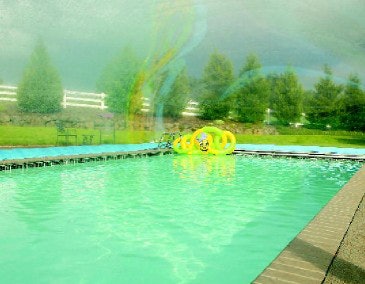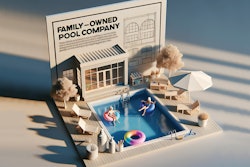
Everyone loves an indoorpool in the winter months or during inclementweather. But no one wants to be indoors on one of those beautiful midsummer days when the sky is blue, the sun is shining and a soft breeze carries a freshscent. No need to choose:Homeowners can have it bothways with a retractable orremovable pool enclosure.
"The best part is the ability to allow the clients to use [thepool] whenever they want to, notjust when weather permits," JeffCarpenter of Roll-A-Cover, Bethany, Conn., explains. "Theycan relax in the enclosure when it's raining or snowing, orif the weather is nice they can open the enclosure andenjoy the outdoors."
Todd Mulvaney of Plastimayd,Oregon City, Ore., manufactures inflatable dome enclosures (think: Hubert H. Humphrey Metrodome inMinneapolis, not the bouncycastle at the company's summerpicnic). He says an enclosure isa way for people to get morevalue from their pool purchases. "A lot of the people we sell towant to use their pools for therapy throughout the winter, orwant to teach their kids to swim,something where it's importantto have the pool open much of the year if not year-round."
From a pool professional's viewpoint, there are two keyreasons to sell temporary enclosures, according to Mulvaney. "One would be a new-poolbuilder who likes to offer it in the fallwith a new pool sale, so they canextend their pool sales into the fall,"he says. It will let the homeownerswim as soon as the pool is completed rather than having to wait untilspring. With that timing, there are acertain number of homeowners whowould put off constructionuntil spring if they weren't ableto swim that fall. An inexpensive enclosure can remove thatobjection.
With the option of "putting the top down," clients extend the season - and the enjoyment - of their pools Domes can extend the season by a few months to the entire year, depending on the climate.
"A lot of builders will offer itat cost on a new-pool sale inorder to close that sale. If abuilder is able to get a $30,000sale and he adds $2,000 to it[the builder's cost for the dome] buthe closed the sale this year asopposed to some other time or to takethe chance of losing it, he'll do it,"says Mulvaney.
For retailers, Mulvaney says, anextended season means a longerequipment- and chemical-buying season. "If [homeowners] keep the poolopen year-round, they are able to sellmore chemicals, are able to sell moreequipment; all the stuff it takes tokeep a pool rolling," he says.
Swim In The Snow
There are two basic types of quickchange enclosures and each has itsadvantages. Perhaps the biggest difference between inflated domeenclosures and telescoping orretractable enclosures is price. Whiledome enclosures cost buildersaround $2,000, telescoping enclosures usually start in the $10,000range and - as with most things inthe pool business - the sky is thelimit. Another significant differenceis that dome enclosures are seasonextenders, rather than solutions for afew rainy days. The enclosure is putup in the fall, allowing homeownersto use the pool for additionalmonths, or even throughout the winter, depending on the location. In thespring, the pool can be opened muchearlier than an unenclosed one. Butwhen the season arrives, the dome is taken down and stored.
This type of enclosureis generally made withextruded-aluminum framing and glazed with polycarbonate panels. Abrand-name polycarbonate you may recognize isLexan, made by G.E. Plastics. Polycarbonate isa tough, dimensionallystable, transparent thermoplastic that is thefavored glazing materialin greenhouses. It's a versatile plastic,suitable for everything from windowpanes to corrective lenses in eyeglasses. It can be UV treated to help filterout harmful light from the sun, too. Itcan also be configured to provideinsulation R-value.
Retractable covers come in a variety of shapes and sizes and with varioustelescoping patterns: Some areopened from one end and telescopedinto the other end. Some are a seriesof progressively smaller sections thatnest one inside the other, while othersretract in more of an accordion style. Some open in the middle with eachhalf retracting to its ownend of the pool. The variety of styles makes it easyto fit almost any pool.
How They Roll
A track system guidessome retractable covers,much like the track that abi-fold closet door travelsalong. Aqua Shield, aBabylon, N.Y., manufacturer, describes the trackmounted system as bothholding the structure inplace and making it easyto open and close. Somemanufacturers say theirtelescoping enclosurescan withstand winds up to130 miles per hour when properlyinstalled. Tracks, however, must beinstalled on a level surface.
When the deck surface is not completely flat, a trackless design (essentially, the enclosure is on wheels) isthe best choice. It takes more time toroll the parts into place, since theyaren't gliding on a track, and in caseof severe weather, the sections mustbe anchored to the ground. Whetherthey run on rails or are trackless,though, most telescoping enclosuresare designed to withstand some snowload. Check with the manufacturerfor specific tolerances to select amodel that's appropriate for the climate.
Under The Big Top
Inflated dome enclosures also comein a variety of sizes and shapes. Andwith a much lower price range compared to telescoping enclosures,domes can be an easy way forbuilders and retailers - even servicecompanies - to give their customersa longer season.
"It's a versatile product, and it's foranyone who has a retail space and hasan installation crew," says Mulvaney. "If you're just running a retail store,you want to have someone install it for the customer, and take it down. That, of course, generates revenue for your store, but also it makesit easier for the homeowner to use. If you're trying to impact your retail store's bottom line, it's a great way to keep the homeowner coming into the store year-round and generate income for your service and installation department. It's a complete profit center in itself." Mulvaney points out thata determined do-it-yourselfer kind of customer can easily install the enclosure without professional help.
While domes do require electricityto operate, the fan is a very frugaldevice. "It's the electricity of a 100 watt light bulb," says Mulvaney. "It's asquirrel-cage fan, just like the ventyou have on your cook top at home. It takes about 15 minutes to inflate,depending on the size. It has a rheostat on it so you crank it up to inflateit, and once it's blown up, you turndown the blower."
Dome enclosures, like their telescoping cousins, also have attachmentoptions. "We have three different types," says Mulvaney. "A cable anchoring system, which is a cablearound the perimeter with a skirt onthe inside that holds the air in. We have a water-tube-type system whichis a water-tube skirt all the wayaround it, but it doesn't physically attach to the deck, it sits on top of the deck [and can accommodate unevensurfaces.]
"The third option is a track systemthat mounts to the deck. All three options have an interior skirt thatloosely seals the dome to the deck. The track system seals so well,according to Mulvaney, that they use afan that both exhausts and brings inair. "The other two systems allow forenough air exchange underneath theskirt," he says.
Keep It Clean
Both types of enclosures require littlemaintenance except for periodiccleaning. In fact, enclosures makepools much easier to maintain. Whenhomeowners hose off their enclosures, they will be happy to see all thedirt that didn't make it into the pool.
Leaves, grass clippings and otherdebris likewise won't ever make it tothe water. UV light is one more thingenclosures can keep out of the water,and that means slower breakdown of photosensitive chemicals. For thedome enclosures, one additional stepis required when the enclosure isremoved for the season. It's muchlike care you'd give a winter cover. "The biggest maintenance is whenyou take it down to store it for thesummer," says Mulvaney. "You wantto clean the top of it and let it drybefore storing it. That's all the maintenance there is."
Regional Differences
While enclosures are sold all overNorth America, in the southernmoststates they tend to be screen enclosures, and in tropical climates, there'sno need for a solid enclosure.
"We sell a lot in the Northwest and the West simply because it's more moist but you don't get the snowloads," says Mulvaney. "If winter means it's 50 and raining outside, it's a perfect product for that. Then we sell a lot in the central United States. If you get too far south, it gets too warm in there during the day."
For consumers, the benefits of an enclosure are pretty obvious. In climates that don't dip too far below 40 degrees, they can easily swim year round under a dome. For builders and retailers, though, it's worth having a close look at domes in particular when dealing with price-sensitive customers. "I imagine there are a number of people who say, 'The season is only three months and I'm only going to use it a couple of hot days in the summer,' and they don't want to spend the money for an inground pool when they will only get three months' use out of it. But withan enclosure, that season can become six or nine months, depending on geography, and now all of a sudden,the in-ground pool makes morefinancial sense."







































